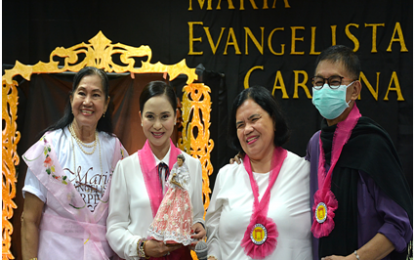
SALUTE TO A ‘FORGOTTEN’ ARTIST. Sta. Rosa City, Laguna Mayor Arlene Arcillas (2nd from left) gets a doll replica of the city-born “forgotten” artist Maria Evangelista Carpena, who was honored as the first Filipina soprano recording artist, during the commemoration of Carpena's 133rd birth anniversary at the Museo de Sta. Rosa on Tuesday (Oct. 22, 2019). Joining Arcillas are Tourism Officer and Museum Curator Nescy Esguerra and Carpena’s descendants led by Dr. Rosauro Sta. Maria (right). (Photo courtesy of Sta. Rosa CIO)
STA. ROSA CITY, Laguna – Mayor Arlene Arcillas on Tuesday led city officials and constituents in paying homage to the country’s first soprano recording artist Maria Evangelista Carpena, whose century-old cultural legacy collections and memorabilia are now housed at the city government museum here.
In gracing the 133rd birth anniversary commemoration of the Rosenian musical artist, Arcillas also recommended the crafting of a City Council resolution to rename the city’s amphitheater into the Maria E. Carpena Hall. The structures is just across the Museo de Sta. Rosa, where the artist’s collections are now on display in celebration of the “Museums and Galleries Month.”
The mayor was moved when musical artists from the Philippine High School for the Arts performed “Ang Maya,” a Filipino old-time favorite folk song which Carpena first recorded in the United States, and the musical recording as well reverberated through the city museum.
Born in Sta. Rosa on Oct. 22, 1886, Carpena is described by local culture and art enthusiasts as one of the most amazing yet lesser-known Filipinas who blazed the trail in the performing arts and carved her mark in Philippine history.
A descendant of Carpena, Dr. Rosauro “Bimbo” Sta. Maria, chief of Laguna’s Tourism, Cultural Affairs and Trade Office (LTCATO), shared that he painstakingly retraced his grandmother’s roots, even scouring the 26-hectare La Loma Cemetery, Manila, in search of the first Filipina soprano diva’s tomb.
“Lelang" (a term of endearment for grandma), as she was fondly called in our family circle and to friends, was known as the “Nightingale of Zarzuela” and amid difficulties in life, blazed the trail for other local singers to be the first Filipino recording artist in 1908,” Sta. Maria said.
Historical accounts revealed that a street in a district in Quiapo, Manila was named after Carpena, an honor that the city leaders and officials here said the Sta. Rosa native greatly deserved, and is now treasured under the Southern Luzon Association of Museums (SLAM) “Project Bayani: Curating South Luzon.”
In an interview with the Philippine News Agency, Nescy A. Esguerra, city tourism officer and curator of the Museo de Sta. Rosa, said the project under the city’s cultural mapping identifies heroes and personages whose outstanding achievements and contributions should be brought to the Filipinos’ national consciousness.
“Actually, kami ay taga-Sta. Rosa na, pero hindi po namin siya nakilala (we who are from Sta. Rosa, do not even know her. Until Dr. Bimbo told us that if Manila had accorded her a place in history, why not for Carpena’s birthplace,” Esguerra said, adding they only learned of a private and personal museum put up by the artist’s family.
She said the city government joined the SLAM’s “Project Bayani” project themed “Building the Nation, One Exhibit at a Time” through their “Masikhaying Bayan - Ani ng Lungsod ng Santa Rosa” highlighting the life and works of Maria Carpena.
She said historical information showed that Carpena, at age 15, was already known for her superb talent in singing but the father, who was no fan of music, prevented her from performing onstage.
“Itinakwil siya ng tatay niya nung nagsikap talaga siya, nagsikhay siya na gusto niyang pangatawanan ang kanyang ambisyon na maging singer (her father disowned her when she really struggled in achieving her ambition to become a singer),” the museum curator narrated.
Unfazed by difficulties in life, Carpena continued her journey to become a musical artist in Manila and stayed at a “beaterio” (convent) at the Colegio de Sta. Rosa in Intramuros, Manila where she tended household chores and embroidery work.
Carpena’s debut performance came at age 15 when she performed for a benefit concert at Zorila Theater in 1901, where she drew applause and admiration.
She had her biggest break in 1902 when Severino Reyes, director of the Gran Compania de Zarzuela Tagala, took her for the lead role in Minda Mora, and went on to be the lead star in stage plays such as “Walang Sugat,” “Lukso ng Dugo” and “La Confianza Mata al Hombre.”
The musical talent further received her “star” when then Governor General Howard Taft invited her to go to the US in 1908, a journey that actually catapulted her name as the first Filipino recording artist in Philippine history through the recordings of “Ang Maya” and other songs accompanied by the Molina Orchestra for Victor Recording Company.
Historical accounts on Maria Carpena displayed at the city government-run museum revealed that “Professor H. Otley Beyer, a renowned anthropologist, described Maria as a “real nightingale” who would “sing at the Luneta to 20,000 people and her voice would be heard clearly through Manila Hotel.”
With neither formal training in voice lesson or reading musical sheets, Maria Carpena’s passion for musicality and the mastery of the musical composition was developed through “oido” or hearing.
A widow with two children, Florita and Jaime, when her husband, Jose “Pepe” Alcantara died in 1904, Maria braved life as a single mom at age 18.
She died at age 28 due to health complications after undergoing appendectomy on March 8, 1915. Her remains were buried at the La Loma Cemetery, Manila. (PNA)
